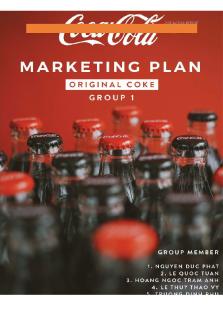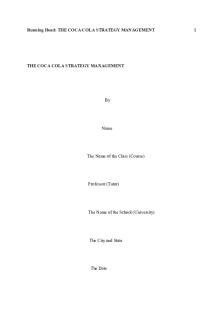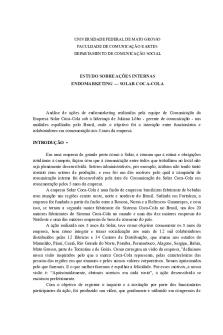Chap 4 - Coca Cola VRIO Analysis PDF

| Title | Chap 4 - Coca Cola VRIO Analysis |
|---|---|
| Course | Strategy Formulation and Implementation |
| Institution | Trường Đại học Quốc tế, Đại học Quốc gia Thành phố Hồ Chí Minh |
| Pages | 2 |
| File Size | 83.4 KB |
| File Type | |
| Total Downloads | 35 |
| Total Views | 167 |
Summary
how to solve this problem...
Description
Coca Cola VRIO Analysis (sources of competitive advantage) Coca Cola is a soda brand known for its large product range, global popularity and presence. The leading soda beverages brand is a global player that sells across more than 200 nations. It also has a global distribution network which enables it to run a global system in partnership with its bottling partners. The main target of the brand is the millennial generation and the brand has traditionally marketed itself as brand for the youth. It sells more than 500 brands of which 22 are billion dollar brands. Coca Cola has also brought health friendly and low sugar options to the market. However, competition has become intense in the soda industry. Another important focus area for Coca Cola is its skilled human resources. It employs more than 700,000 people around the world. Apart from hiring the best, it also focuses on their training and education for keeping its staff motivated and focused. This is a VRIO analysis of Coca Cola that analyzes how well its strengths are suited and organized to provide it a sustainable competitive advantage. Most important resources of coca Cola that can give rise to competitive advantage: • • • • • • •
Global distribution network Large product range Skilled human resources Marketing skills and expenses Secret formula Brand image Research and development
Main competitors of coca cola: Pepsico and Dr Pepper Snapple are the main competitors of Coca Cola. Of these two, Pepsico is the biggest competitor which is equipped with some formidable strengths and therefore the two giants- Coca cola and Pepsi are constantly in a battle for market share. Several of the resources and strengths of the two brands are also quite similar and therefore even small points of differentiation matter. The two giants are also engaged in a marketing battle. However, Coca Cola’s expenditure on marketing is significantly higher. Below is a VRIO analysis that further highlights how Coca Cola’s resources provide it with sustainable competitive advantage. VRIO Analysis: Valuable: is the capability/ resource competitively valuable? • • • • • • •
Global distribution network – Yes, it is an important resource enabling Coca Cola to serve the global market and maintain a global presence. Large product range: Yes, it has helped Coca Cola reach and serve the global audience with different tastes. Skilled human resources: Yes, it helps Coca Cola manage its large system efficiently. Marketing skills and expenses: Yes, it helps Coca Cola manage a differentiated brand image and connect with its audience better. Secret formula: Yes, this is something accessible to only a few people in the entire Coca Cola system. Brand image: Yes, brand image drives value and is important for managing an impressive market presence. Research and development: Yes, it helps Coca Cola to continuously innovate and respond to changing market situations.
Rare: is it something rivals lack? • •
Global distribution network – Possessed by only a few other firms in the soda industry and helps coca Cola manage its global reach. Large product range – Not absolutely rare, Pepsi and Dr Pepper Snapple also deal in a large product range.
• •
• • •
Skilled human resources – Yes, Coca Cola is ahead of all the other companies in the soda industry in terms of human resource management. Marketing skills and expenses – Coca Cola’s marketing expenses are around $4 billion which is far higher than that of its competitors. While marketing skills can be matched matching the high level of expenses is very difficult for any firm. Secret formula – Rare, However, Pepsi and Dr Pepper Snapple also serve unique flavours. Still, the differentiated flavour of Coca Cola gives the company an edge in terms of competition. Brand image – Yes, it is not easy to build a strong brand image like Coca Cola. However, Pepsi also has a strong brand image. Research and development – Yes, but Pepsi too places heavy focus on R&D.
Imitability: is it hard to copy? • • • • • • •
Global distribution network: Pepsi also has a global network of distributors. Large product range – Pepsi also has a large product range. Skilled human resources – yes, it is difficult to imitate the competitive advantage generated by skilled human resources. A high expenditure is involved in hiring, training and paying skilled professionals. Marketing skills and expenses: Difficult to copy because of the high expenses. – competitive parity Secret formula: not possible to imitate Brand image: Not possible to imitate. However, a competitor’s strong brand image can be a threat Research and development: Not inimitable because other firms too invest in R&D.
Organization: firm’s policies and procedures are properly organized to help it exploit its valuable, are and inimitable resources. • • • • • • •
Global distribution network – Yes. Large product range – Yes Skilled human resources – Yes Marketing skills and expenses – Yes Secret formula – yes Brand image – Yes Research and development – Yes
Provides a sustainable competitive advantage. • • • • • • •
Global distribution network – No, just a temporary advantage because Pepsi can imitate easily. Large product range – No, just a temporary advantage because Pepsi can imitate easily. Skilled human resources – competitive parity because involves heavy expenditure. Marketing skills and expenses – competitive parity because involves heavy expenditure. Secret formula – Yes. – Sustainable competitive advantage Brand image – to some extent, because just one competitor, Pepsi has as strong image in the market. Research and development: To a small extent only. (competitive parity)...
Similar Free PDFs

Chap 4 - Coca Cola VRIO Analysis
- 2 Pages

Coca-Cola Analysis
- 13 Pages

COCA COLA Equipo 4
- 15 Pages

SWOT Analysis for Coca Cola
- 4 Pages

Pestle Analysis of Coca Cola
- 1 Pages

COCA COLA - Apuntes 3-4
- 16 Pages

Coca cola
- 7 Pages

Coca Cola-SWOT - Coca Cola-SWOT
- 4 Pages

PROCESO ADMINISTRATIVO COCA COLA
- 1 Pages

COCA-COLA CASE STUDY
- 13 Pages

Coca Cola Strategy Management
- 9 Pages

Endomarketing - Solar Coca-Cola
- 5 Pages

Coca cola case study
- 2 Pages
Popular Institutions
- Tinajero National High School - Annex
- Politeknik Caltex Riau
- Yokohama City University
- SGT University
- University of Al-Qadisiyah
- Divine Word College of Vigan
- Techniek College Rotterdam
- Universidade de Santiago
- Universiti Teknologi MARA Cawangan Johor Kampus Pasir Gudang
- Poltekkes Kemenkes Yogyakarta
- Baguio City National High School
- Colegio san marcos
- preparatoria uno
- Centro de Bachillerato Tecnológico Industrial y de Servicios No. 107
- Dalian Maritime University
- Quang Trung Secondary School
- Colegio Tecnológico en Informática
- Corporación Regional de Educación Superior
- Grupo CEDVA
- Dar Al Uloom University
- Centro de Estudios Preuniversitarios de la Universidad Nacional de Ingeniería
- 上智大学
- Aakash International School, Nuna Majara
- San Felipe Neri Catholic School
- Kang Chiao International School - New Taipei City
- Misamis Occidental National High School
- Institución Educativa Escuela Normal Juan Ladrilleros
- Kolehiyo ng Pantukan
- Batanes State College
- Instituto Continental
- Sekolah Menengah Kejuruan Kesehatan Kaltara (Tarakan)
- Colegio de La Inmaculada Concepcion - Cebu


